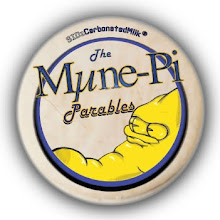The record of the recording of this record plays like a broken record. Again, there I was, just minding my own business (shepherding plug-ins). We wuz just fooling around, y’know? One thing led to another; and here I find myself fettered with the responsibility of raising yet another brainchild. …another mouth-ed idea to feed yaz.
Earlier this year, I had added another UAD-2 card to Lake Gennesaret [<Luke5><] Studio PS—our SCM/Entejé home-lab. For my purchase, I received a coupon for $500 to add any UAD plug-in. There among the only offerings available not already in my possession were the Moog™ filter and their SSL™ emulations. I run a dual platform DAW system in my studio; and while I had the Moog™ and SSL™ in forms of the Arturia™ Minimoog V® and Waves™’ SSL® Collection on my Intel Extreme PC respectively, it was nice to add these functions to the Mac UAD-ively.
I was most curious to test the Moog® filter. I booted up Cubase 5®, and chose a simple HALion One slap bass preset. What I heard was love at first insight; I had achieved finally what I’d tried on two prior song attempts on “the Mμne-Pi Parables”. When many think of P-Funk bass lines, two players readily come to mind: ironically, keyboardist Bernie Worrell for his synth bass on “Flashlight” and Bootsy for everything Bootsy he does. Back in my casual neophyte Funk-a-teer pupa stage, the work of Cordell “Boogie” Mosson went much unappreciated by me; I had missed the point of the Funk. The point is, that touch of his. There are subtleties to his play that dig into the groove like a snide retort uttered under one’s breath to be picked up later off the cerebral echoes. Cordell’s style inspired my bass line on “How Long Is Wrong?” (His influence is also heard on chapter 19’s “Let’s Just Get Along” synth bass). Though it is number ten on the “Mμne-Pi” playlist, it comes in as the twenty-second and final brick in the wall of sound on a project that began as a mere seven song instrumental EP. I can justify its inclusion by its strong P-Funk drive.
On ohiofunk.org, one of our pet peeves is the confusing of Funky with Funk. Having worked with and for George Clinton as a P-Funk Labs technician (I worked the MIDI room at United Sound Studios…performing sequencing (on Roger Powell’s “Personal Compser”, drum machine and synthesizer programming duties—utilizing the latter to wedge myself into live session work as a keyboardist), I make my funk the P-Funk. That said, there does exists extra-Clintonian life on Funk. …Ohio Players (see Westbound Records) and (pre-J.T.) Kool and the gang, for example. But where I take issue with the misappropriation of Funk acceptance is when I read the titles on the labels of so-called Funk compilations and find the likes of “Le Freak”, “That’s the Way I like It”, and “Brick House”—all mega-funky, just not really Funk in my book. Things often especially go wrong when some church super-group ensembles attempt the funk by way of funky. This is all that I say about that, except to say that we endeavor not to fall under the weight of our own condemnations—not to be hoisted on our own petards—by talking up the funk and only man-you-funkering the funky fake. The second and most important need for what “HLIW” offers is its lyrical reinforcement of our morality manifesto.
Also, from the standpoint of flow and feel, I felt the jump from “Can I Fly…” to “Enter Mission…” was a bit abrupt. “…Wrong?” is a good answer to “That Said…”—parenthetically sandwiching the non-funk varieties between them, and forecasting the Funk storm rolling in in part two: “Da Hark-side of the Mμne”.
Melodically, “…Wrong” has much in common with “Erase the Load” from the “Men in Martian’s Ice” project [SIDzCarbonatedMilk II (2000)].
Introducing: The Amazing Kenny.
Vocally, HLIW is a sibling to what you will hear performed on Chapter 13’s “Cancer”. The obvious difference between the two is in the seminal lead vocal line upon which the fluid harmonies that shape this song are built. Some will recognize influences such as Sly Stone and Al Jareau. If so, this was the intention all the while; if not, it’s all my invention. Originality is the inability to name your source (If you don’t know who said this originally, then it was me. …dem’s da rules).
I had toyed with vocal-leading throughout with a vocoder; then I thought maybe vocoded male with female voices (add SiloamPool and stir). Finally, after having the Amazing Kenny Watson in studio to tighten a few of his lead and side-vocals on Ch. 17’s “Tempted and Tested”, I invited him to add his voice to the chorus vamp of HLIW.
Kenny
“Yeah…hmm. I don’t know what I can do with that”
SID
“Aw…really? …no problem. Then let’s try just the vamp chorus…how long is wrong?”


No comments:
Post a Comment